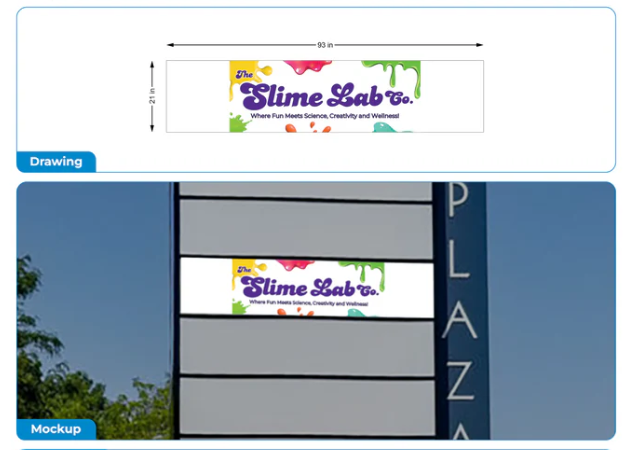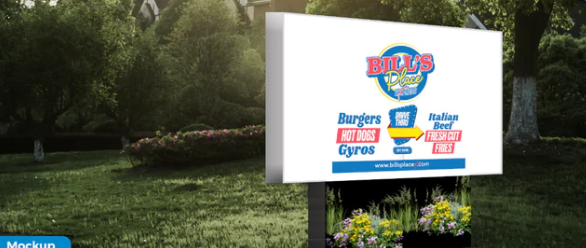When selecting signage for your business, it’s important to understand the differences between key sign types, especially when comparing monument signs vs pylon signs. These two outdoor signs are among the most effective for enhancing brand visibility along roadways, in business parks, or near shopping centers. But which one is the right choice for you?
To help guide your sign project, this article will explore the pros and cons of pylon and monument signs, analyze key factors such as sign height, visibility, maintenance, and cost considerations, and help you align your decision with local zoning regulations, audience needs, and branding goals.
Understanding Monument Signs
Monument signs are ground-level structures often made from high-quality materials like stone, concrete, brick, or aluminum. With their aesthetic appeal and sturdy presence, these signs are ideal for businesses seeking a timeless, elegant brand presentation.
You’ll often see monument signs outside educational institutions, corporate campuses, healthcare facilities, and upscale residential complexes. They’re a cornerstone of traditional to modern signage strategies because they preserve architectural character while allowing updated lighting and branding elements.
Unlike taller options, monument signs are typically 3–6 feet high and sit close to eye level, making them easy to read for pedestrians and drivers in high-foot-traffic areas. Designed to blend seamlessly with surrounding architecture or landscaping, monument signs serve as a statement piece and directional tool.
Pros of Monument Signs
- Strong aesthetic appeal with options for intricate designs
- Built with durable materials for minimal maintenance
- Ideal for businesses aiming to present a high-end look
- Smooth integration with landscapes for upscale properties
- Compliant with most local zoning laws due to low height
Cons of Monument Signs
- Limited sign visibility from longer distances or fast-moving traffic
- Less effective near highways or busy roads
- May require more land or landscaping for installation
- Fewer customization options for height and electronic components
| Branding Tip: Framing and scale shape perception. The shape and proportion of your signage affect how your brand is perceived. A low, wide monument suggests stability—while a tall pylon signals bold visibility. |
Understanding Pylon Signs
Rising high into the skyline, pylon signs are built for maximum visibility. Also known as pole or freestanding signs, these structures range anywhere from 20 to 80 feet in height and are commonly used near shopping centers, multi-tenant properties, or alongside highways and industrial areas.
Pylon signs typically feature one or more support columns and can display channel letters, cabinet signage, or integrated digital displays for pylon signs with LED displays or electronic components. Their towering presence makes them ideal for businesses located near major intersections, large parking lots, or busy commercial roads.
Pros of Pylon Signs
- Superior sign visibility from long distances
- Ideal for attracting motorists traveling at high speeds
- Supports multiple tenants—great for multiple businesses
- Integrated illumination options for enhanced nighttime visibility
- Versatile in sign height, materials, and display formats, including digital or electronic signage
Cons of Pylon Signs
- Typically require more maintenance, especially with lighting options
- Subject to strict local zoning regulations and wind load limits
- Less refined in appearance for certain settings
- Higher initial investment in comparison to smaller signs
Monument Sign vs Pylon Sign: Key Differences
When comparing monument signs and pylon signs, several key distinctions emerge based on location, audience, and functionality. Here are the primary differences every business should understand:
|
Feature |
Monument Signs |
Pylon Signs |
|
Visibility |
Great for nearby walkers/drivers |
Excellent for distant/high-speed visibility |
|
Height |
Low profile at ground level |
Tall height (20–80 feet) |
|
Aesthetic Appeal |
Strong design integration |
More functional, less decorative |
|
Ideal Locations |
Business parks, schools, offices |
Shopping centers, high traffic areas |
|
Lighting |
External or embedded lighting |
Backlit, LED, or digital displays |
|
Sign Type |
Often static, elegant directories |
Highly visible, flexible for digital integration |
|
Sign Project Cost |
Mid-range, cost-effective |
Higher due to structure, tech, and height |
Choosing the Right Sign for Your Business
So which should you choose—monument or pylon? That decision depends on several factors, including your location, target audience, and budget.
Here’s when to choose each:
Choose a Monument Sign if:
- Your location is walkable, such as in business parks or residential districts
- You want a sign with strong aesthetic appeal and permanence
- Local zoning regulations prevent tall structures
- You're branding a single business rather than housing multiple businesses
- You prefer architectural integration and minimal maintenance
Choose a Pylon Sign if:
- You're targeting potential customers along highways or busy roads
- Your location involves shared tenants in shopping centers or strip malls
- You need to reach customers at a distance or those driving at high speeds
- You're using digital displays or rotating messages
- Height advantage, nighttime visibility, or advertising flexibility is a top priority
In either case, making the right choice helps elevate brand recognition, attract attention, and create a lasting impression—all while respecting local zoning laws and environmental conditions.
|
Branding Tip: Illumination should match brand atmosphere. Backlit logos or soft halo lighting can create a refined look at night. Match lighting style to your brand mood—inviting, sleek, vibrant, or classic. |
Cost Considerations and Long-Term Value
When comparing pylon sign vs monument sign, cost is a major deciding factor. While pylon signs involve more maintenance, structural engineering, and LED options that increase price, they frequently offer better ROI for businesses seeking maximum visibility in fast-paced areas.
In contrast, monument signs are often more cost-effective up front. Their simpler structure and long-lasting materials make them ideal for long-term benefits without the need for constant electrical servicing.
Factors That Affect Cost:
- Sign height and size
- Lighting options (LEDs, embedded illumination)
- Customization options such as channel letters or stone facades
- Site preparation, landscaping, and installation requirements
- Material selection (stone, aluminum, brick)
Ultimately, the right sign balances visibility, durability, maintenance, and budget, and ensures compliance with local regulations.

Explore Which Sign Type Fits Your Business Best
Choosing between pylons and monument signs isn’t always straightforward, especially when juggling local regulations, visibility goals, and cost considerations. At Signs.inc, we help you assess location, design, and material combinations to select signage that meets your business needs now and well into the future.
Whether you need one striking monument sign or a towering pylon sign, our team brings experience in permitting, design, and fabrication using high-quality materials backed by best practices in signage and installation.
Let’s work together to develop signage that reflects your unique brand, withstands the elements, and delivers real long-term benefits.





